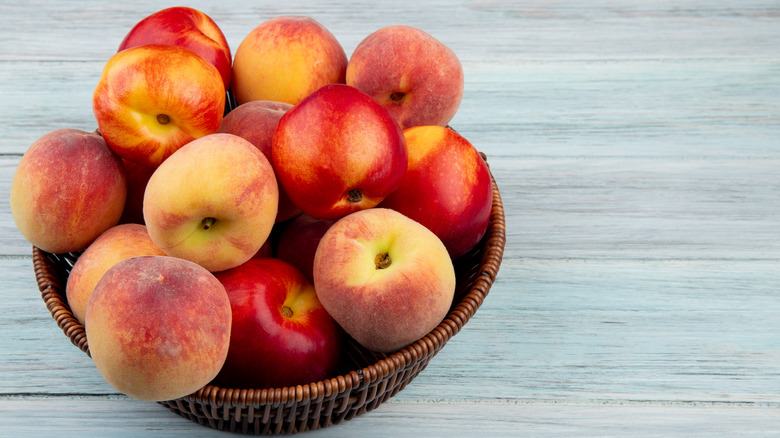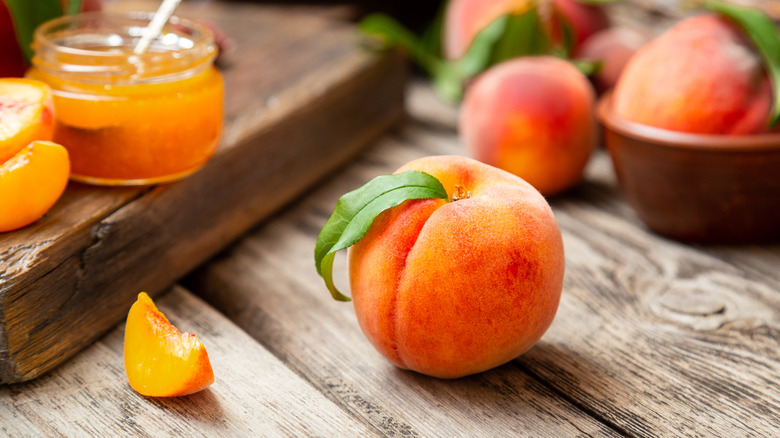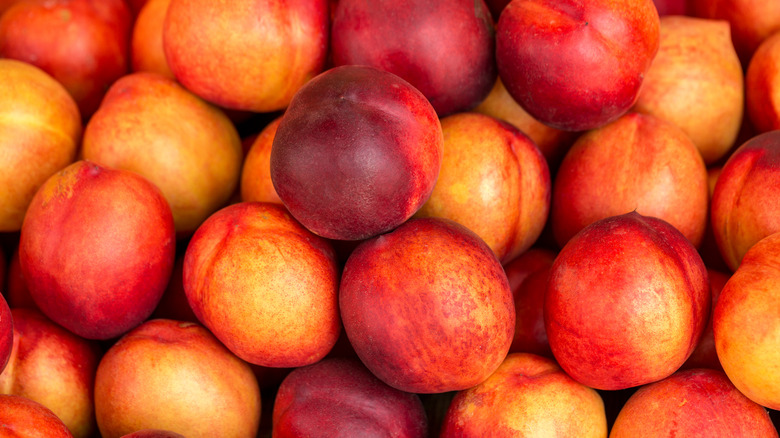The Difference Between Peaches And Nectarines
From ripe berries to sweet, juicy plums, it seems like summer is the best time to enjoy the most delicious in-season fruits. The months from May to September are the prime time for a number of sweet summer fruits, including tart blackberries, blueberries, watermelon, and stone fruits like juicy peaches and fresh, sweet nectarines (per Greatist). However, these two summer stone fruits are so similar that many people might not even realize there is a difference between the two at first glance. So what exactly is the difference between a peach and a nectarine?
It turns out that, on a genetic level, there really isn't a big distinction between these two popular fruits. According to Healthline, their genetic makeup is nearly identical. In fact, it's a simple genetic mutation that separates nectarines from their close cousin, the peach. However, that doesn't mean peaches and nectarines are exactly the same. Although these two fruits might seem very similar at first glance, peaches and nectarines differ in appearance, texture, and even nutritional value.
The skin of the fruits are different
Peaches are at their peak season from May to late September, according to The Peach Truck. They grow well in warm, mild climates, which is why states like Georgia, California, and North Carolina are known for their peach crop. Peaches are most easily distinguished by the light, fuzzy coating they have on their skin. This fuzz provides a thick, protective coat that helps prevent the fruit from bruising and lessens the damage caused by moisture. The inside of a ripe peach tends to be soft, sweet, and juicy.
Nectarines are also a summer fruit, although they reach their peak slightly earlier, generally from April to the end of August, according to Kitchen Stories. Unlike the peaches' fuzzy exterior, nectarines are easily identified by the thin, smooth skin that covers the flesh. While some people might prefer nectarines due to their lack of fuzz, the nectarine's smooth skin actually makes it more prone to damage and disease, which can make it harder to grow. While ripe nectarines are also sweet and juicy, they also tend to be smaller and have firmer flesh than a peach, according to Healthline.
How peaches and nectarines are similar
While some people might swear that one fruit is sweeter than the other, the sweetness of a peach or nectarine actually has less to do with their differences than with their individual ripeness, according to The Kitchn. The flesh of fresh, ripe peaches and nectarines should be sweet, succulent, and juicy, and the skin should be aromatic and slightly soft to the touch.
Both peaches and nectarines contain a number of health benefits. While peaches generally contain slightly more calories, carbs, and sugar, both fruits contain a number of nutrients like fiber, potassium, niacin, and vitamins A, C, and E (per Healthline). However, nectarines have a higher amount of vitamin C and potassium, and almost double the amount of vitamin A than peaches (per Ackerman Cancer Center). Both fruits are great sources of antioxidants that can help boost the immune system and decrease the risk of developing many different types of cancer, including lung, stomach, mouth, prostate, and colorectal cancers.
Because they have such a similar flavor profile, peaches and nectarines are also pretty much interchangeable in a number of recipes. Peach pies, peach cobblers, and even peach margaritas could be easily substituted with nectarines if they happen to be what you have on hand. So no matter if you prefer the smooth skin and firm flesh of a nectarine, or the soft, fuzzy sweetness of a peach, you really can't go wrong with either one of these tasty and nutritious fruits.


